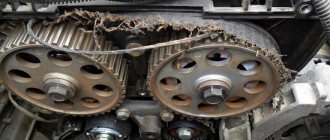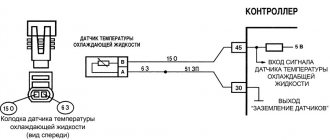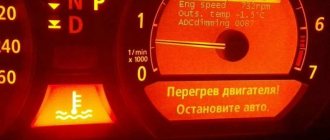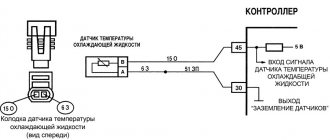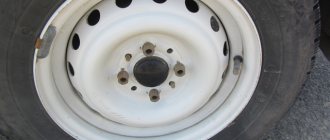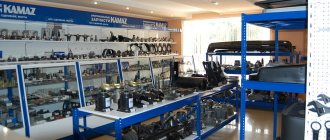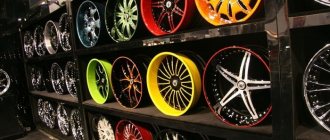The absence of a spare tire or a standard “dokatka” seriously complicates the situation. If the driver has the skills, you can put a temporary patch on the puncture, otherwise you will have to order a tow truck.
We recommend taking with you a spare tire, a repair kit for different occasions, and the necessary tools, then you can get out of any road situation with dignity. If all this is missing, then you can drive a short distance to a service station or tire shop on broken tires. We are not talking about hundreds of kilometers of travel, we are talking about a short distance.
Causes of pressure loss
Air leakage from a car tire can occur in different situations. In this case, it is not necessary to punch through; there are other unforeseen and unpleasant situations. The most common:
- A puncture is the most common accident on the road. In this case, the situation may worsen if the puncture is slow, that is, a sharp object is stuck in the tire and the air comes out very slowly, the driver will find out about this later, when it is completely deflated. In this situation, if you identify a puncture, you can slowly drive to the tire shop, after pumping up the air.
- A cut is a more serious problem than a puncture. The size of the damage is larger, air flows out faster and the tire flattens almost instantly. In this case, damage can occur to both the main part of the tire and the side part. The side part is thinner and easy to cut. Particularly dangerous in this regard is careless driving on the side of the road, near curbs, and in ruts with sharp edges. Once a tire is cut, it is practically impossible to repair; it only needs to be replaced with another one.
- Malfunction of the valve (spool) - this also occurs. You can simply tighten it with a wrench, otherwise you will have to change the part.
- The source of air leakage from the wheel is the nipple - it can be treated by simply tightening it.
Potholes or unevenness on the road can create a serious problem. Hitting such an obstacle at high speed can lead to deformation of the car rim and subsequently damage to the rubber. This is a very serious damage that cannot be corrected on your own without the use of special equipment; you need to go to a tire repair shop.
Use of worn-out car tires - it is necessary to adhere to the service life specified by the manufacturer. Otherwise, the wheel may go flat due to excessive wear. There is a risk of explosion during operation.
Problems exist with tubeless tires - the fitting sometimes does not fit well to the rim, and air leaks occur.
The main reasons that lead to damage to car tires and air leakage are indicated. Whether it is possible to drive on a flat tire is determined by the driver himself, taking into account his experience and capabilities.
How to quickly get repairs on the road
Tire damage is not always so critical that it requires urgent repairs. If you just notice a “passenger” (that’s what nails and other sharp objects embedded in a tire are called in driver’s slang), but the tire holds pressure and doesn’t deflate, then don’t rush to pull it out. This way you can not only get to the nearest service station - you can drive like this for weeks. The main thing is that the nail does not fly out on a bump at the most inopportune moment.
Small punctures and cuts through which air barely escapes can be sealed without removing the tires: to do this, buy a puncture-proof can from a car store. It is pumped directly into the wheel. And the smart chemistry mechanism itself finds the hole and seals it.
Danger of driving on a flat tire
Driving with a completely flat tire is not recommended. Driving a car becomes significantly more difficult, there is a risk of getting into an accident and creating a threat to other road users.
Some of the main problems that can result from driving with low tire pressure include:
- the car may deviate from the main trajectory of movement, go to the side;
- the problem described earlier manifests itself more strongly with increasing speed, the car becomes practically uncontrollable;
- increased fuel consumption is an inevitable companion to driving with a flat tire;
- a completely flat tire runs the risk of side part damage and cuts, which can render it completely unusable;
- due to increasing pressure on the disc, there is a risk of rubber damage;
- Driving for a long time on a flat tire leads to tire disassembly and subsequently damage to the disc;
- sharp maneuvers are difficult, this is one of the factors of the accident.
A flat tire is a source of serious danger. Every driver should understand this and take all necessary measures to eliminate the problem. Under no circumstances should a puncture be ignored; at high speed the situation can get completely out of control. The ideal would be to replace the wheel with a spare one and have it repaired at the nearest tire shop.
A car tire is a complex system. Consists of different elements. Manufacturers use special technologies and materials to provide the vehicle with the declared driving characteristics. The special pattern on the main part of the tire has its own functionality and is not purely for beauty. Any deviation from the norm leads to a decrease in the functionality of the tire, and accordingly the car loses its quality. Its use becomes unsafe until the problem is resolved.
How to feel a flat tire when driving?
If the driver has not carefully checked the wheels before driving long distances, then while driving he should listen to sounds and feel some unusual movements of the car when driving. Depending on the reason for the flat tires, the car may behave differently, but one way or another, manifestations uncharacteristic of normal driving will appear:
- The vibration will change;
- Additional sounds appear in the form of tapping, humming, noise, etc.;
- The body may sway unusually;
- The car seems to be pulled to the side;
- Depreciation is reduced;
- You can feel a beating in the steering wheel, which may intensify as the speed increases;
- Driving the car becomes more difficult;
- Increased fuel consumption and so on are noticeable.
If you feel something strange in the behavior of your car, look for a safe place to park and inspect it.
Popular tire models
- Yandex.Market rating: Yandex.Market: 4
Goodyear Eagle F1 Asymmetric 3 SUV tiresSeasonality: summer Spikes: no Diameter: / 17 / 18 / 19 / 20 / 21 / 22
More details
- Yandex.Market rating: Yandex.Market: 4.5
Goodyear Eagle Sport TZ tires
Seasonality: summer Spikes: no Diameter: 16 / 17 / 18
More details
- Yandex.Market rating: Yandex.Market: 4
Goodyear EfficientGrip 2 SUV Tires
Seasonality: summer Spikes: no Diameter: 16 / 17 / 18 / 19 / 20 / 21 / 22
More details
- Yandex.Market rating: Yandex.Market: 4.5
Goodyear EfficientGrip Performance Tires
Seasonality: summer Spikes: no Diameter: 15 / 16 / 17 / 18 / 19 / 20
More details
- Goodyear UltraGrip Arctic 2 SUV Tires
Seasonality: winter Spikes: yes Diameter: 17 / 18 / 19 / 20 / 21
More details
- Yandex.Market rating: Yandex.Market: 4.5
Goodyear UltraGrip Ice 2 tires
Seasonality: winter Spikes: no Diameter: 15 / 16 / 17 / 18 / 19
More details
- Yandex.Market rating: Yandex.Market: 4.5
Goodyear UltraGrip Ice SUV Tires
Seasonality: winter Spikes: no Diameter: 16 / 17 / 18 / 19 / 20 / 21
More details
- Yandex.Market rating: Yandex.Market: 5
Goodyear Vector 4Seasons Gen-3 SUV Tires
Seasonality: all-season Spikes: no Diameter: 16 / 17 / 18 / 19 / 20
More details
- Yandex.Market rating: Yandex.Market: 4
Goodyear Wrangler HP All Weather Tires
Seasonality: summer Spikes: no Diameter: 16 / 17 / 18 / 19
More details
- Yandex.Market rating: Yandex.Market: 4.5
Goodyear Vector 4Seasons tires
Seasonality: all-season Spikes: no Diameter: 15 / 16 / 17 / 18
More details
- Yandex.Market rating: Yandex.Market: 4.5
Goodyear Wrangler All-Terrain Adventure tires with Kevlar
Seasonality: summer Spikes: no Diameter: 15 / 16 / 17 / 18 / 20
More details
- Yandex.Market rating: Yandex.Market: 4.5
Goodyear EfficientGrip SUV Tires
Seasonality: summer Spikes: no Diameter: 16 / 17 / 18 / 19 / 20 / 21 / 22
More details
- Yandex.Market rating: Yandex.Market: 4
Goodyear Eagle F1 Asymmetric SUV tires
Seasonality: summer Spikes: no Diameter: 17 / 18 / 19 / 20 / 22
More details
- Goodyear UltraGrip Performance+ SUV Tires
Seasonality: winter Spikes: no Diameter: 16 / 17 / 18 / 19 / 20 / 21
More details
How to get to a tire shop if a tire has burst
When creating a mandatory first aid kit for victims in a car, you must also not forget about the “medicines” intended directly for the vehicle itself. Along with a jack and keys, special tools should be available to solve the problem of damaged tires. Do not think that using a sealant or any other means can completely restore a tire, regardless of the degree of damage and the nature of the “wound”. Of course this is not true. The manufacturer provides a guarantee for the use of funds in the following cases:
- if there is a puncture on the tires;
- if the diameter of the “wound” does not exceed 6 mm.
You can find damage and determine its size using water. Where bubbles begin to appear on the tread is where the car “wound” is located.
If all points are met, then you can use the available product. To do this, you need to perform the following manipulations:
- Install the tire so that the valve is at the bottom.
- Unscrew the spool.
- Pour in the product.
- If necessary, use a pump and inflate the tire.
Sealants contain substances whose distinctive feature is complete hardening upon contact with air or any other gas. Thus, the chemical reaction occurring at the puncture site ends with the formation of a kind of “plug” that prevents the tire from deflating.
Note!
Sometimes the cause of a puncture is a screw caught in the rubber. If you discover such an incident, do not rush and remove the unpleasant find from the wheel. It is much more practical to try to tighten the screw into the tire as much as possible, thus creating a kind of obstacle to the tire deflating.
So that the car enthusiast does not worry about how long he can drive on a flat tire, tire manufacturers offer their consumers new and improved technologies. Thanks to this, tires have appeared that can continue driving after a puncture.
A tire designed in this way is called runflat.
The ability to drive “on a flat tire” appears with tires that have been upgraded in one of the following areas:
- A support tire has an elastic ring that is installed on the rim and provides additional support for a flat or punctured wheel.
- Load-bearing tire, or “zero pressure tire”. Thanks to its special composition, its rubber is reliably protected from the heat that inevitably occurs during movement of a punctured wheel. This is also facilitated by the ribs protruding on the sides of the wheel. In general, the technology comes down to increasing the strength of the sidewall and frame. To use such tires, the owner must have a tire pressure monitoring system.
- A self-sealing tire is reinforced with a protective inner layer that contains sealants that can regenerate small holes in cases where the rubber is damaged while the vehicle is in motion.
Runflat tires, unfortunately, are not without their drawbacks:
- Despite the increased cost compared to the price of a regular tire, they are practically irreparable.
- Runflat operation is only possible with a system that controls the pressure level.
- The reinforcing effects not only increase the tire's reliability, but also its overall weight. This circumstance affects the overall driving characteristics of the vehicle.
It is necessary to remember: a wheel that has received a puncture cannot be considered full-fledged.
Each of the listed methods for eliminating a puncture makes it possible to safely get to the auto center.
How long and how can you drive with low pressure?
It is worth noting that you cannot drive with a completely flat tire under any circumstances. The situation can get out of the driver’s control at any time; the tire will fly off the rim, causing damage that will lead to new problems. It is best to call a tow truck, regardless of the cost.
An exception to the rule may be a tire that still has some air left in it. You can try to get to a service station or tire shop. You can also try to re-inflate the tire to give yourself more time.
Driving with low pressure is possible subject to the following rules:
- minimum driving speed;
- movement occurs without creating interference for other road users;
- sudden maneuvers on the road are not allowed;
- You should be careful about holes and unevenness;
- Periodically it is necessary to monitor the condition of the wheel, stop and check the tire.
The average distance allowed for driving a car with a half-flat tire is 10 kilometers. This is only permitted if the above rules are observed.
If there is nothing to repair
If trouble happens by an unfortunate accident when you have nothing to deal with it: you can try to get to the workshop on a flat tire. In some cases, such a risk is justified: If the air does not come out too quickly, then you will have time to get there. As a last resort, be patient and pump up the damaged tire every kilometer or two.
Before setting off, inflate the tire to the maximum. This way you can drive longer without stopping. If you feel the behavior of the car characteristic of a flat tire, repeat the manipulations.
Consequences
Failure to promptly resolve problems with low tire pressure, punctures or other damage leads to negative consequences. Problems with the following systems may occur:
- brakes - operating efficiency is significantly reduced, which is especially pronounced during moments of sudden braking;
- steering system - sharp maneuvers are difficult, any turn can be accompanied by a skid of the car, steering the car becomes impossible;
- wear of steering system elements;
- punctured tires begin to overheat, which negatively affects their service life;
- increased fuel consumption - this is due to the increased rolling resistance of a flat tire;
- vehicle dynamics are reduced.
A car with flat tires poses a danger to other road users and its driving characteristics are distorted.
It is necessary to understand that driving with insufficient pressure leads to deformation of the rubber. You risk completely damaging the tire and subsequently replacing it with a new one. Therefore, the decision to drive on half-flat tires must be made carefully, carefully assessing all the consequences and alternatives. For example, estimate the cost of replacement, repair of other damage with the price of a tow truck service or calling a mobile tire service team.
The maximum speed of a car with a half-flat tire depends solely on the characteristics of the tires, the type of vehicle, and other nuances. When accelerating to a speed of more than 30 km/h, complete disassembly is possible and the tire flies off the rim.
We recommend that you have with you a spare tire or a spare tire, which is supplied with the car by the manufacturer, or a repair kit. You will be able to temporarily revive the tire, it will not go flat and you will be able to get to the tire shop.
A small reminder from Michelin
Flat tire: Cause: tire damage requiring repair
- Most punctures or cuts in the tread up to 6mm in size can be repaired by a tire specialist using quality materials and techniques.
- The harness can only be used as a temporary repair, since after a puncture it is also necessary to remove the tire from the rim and examine the inside of the tire.
Solution:
- Replace the damaged tire with a spare. However, before you do this, be sure to check the correct air pressure in your spare tire and read any speed and mileage restrictions placed on it.
- After this, take the damaged tire to a tire center specialist for inspection and repair.
Reason: underinflated tires
- Tire life is reduced due to increased wear in the shoulder areas.
- The tire overheats, which can lead to tire damage or even destruction.
- Due to increased rolling resistance, fuel consumption increases.
Solution:
Inflate the tire until it reaches the correct air pressure. To find out the recommended air pressure for your tires, consult your vehicle's owner's manual or check the value on the sticker on the driver's door of your vehicle.
Advice from "Behind the Wheel"
Since the mid-2000s, foreign cars began to be equipped with tire pressure sensors. This active safety system will alert you to a puncture before the driver even notices it. Thanks to Chinese industry, today any car can be equipped with such an option, and very inexpensively. A useful thing - we recommend it!
The main thing during a puncture is don’t panic! The car's three wheels remain and do their job. In the end, even motorcyclists manage to keep the bike upright and stop normally when they get a puncture.
- Read what to do when braking is useless in this publication.
- You can prove the circumstances of any event using a video recorder. The COMBO ARTWAY MD-106 3 in 1 Super Fast multifunctional device is a video recorder, a radar detector, and a GPS informant.
